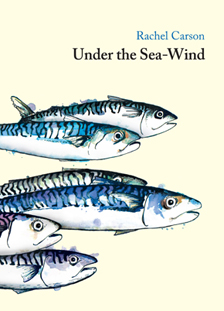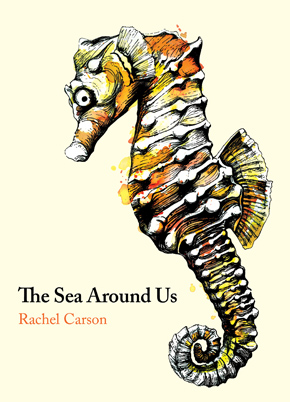The marginal world
by Rachel Carson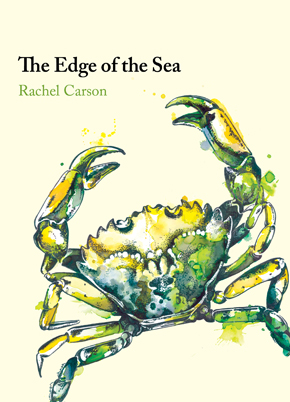
“No other writer speaks so unabashedly about beauty and wonder.” John Burnside, New Statesman
The edge of the sea is a strange and beautiful place. All through the long history of Earth it has been an area of unrest where waves have broken heavily against the land, where the tides have pressed forward over the continents, receded, and then returned. For no two successive days is the shoreline precisely the same. Not only do the tides advance and retreat in their eternal rhythms, but the level of the sea itself is never at rest. It rises or falls as the glaciers melt or grow, as the floor of the deep ocean basins shifts under its increasing load of sediments, or as the earth’s crust along the continental margins warps up or down in adjustment to strain and tension. Today a little more land may belong to the sea, tomorrow a little less. Always the edge of the sea remains an elusive and indefinable boundary.
The shore has a dual nature, changing with the swing of the tides, belonging now to the land, now to the sea. On the ebb tide it knows the harsh extremes of the land world, being exposed to heat and cold, to wind, to rain and drying sun. On the flood tide it is a water world, returning briefly to the relative stability of the open sea.
Only the most hardy and adaptable can survive in a region so mutable, yet the area between the tide lines is crowded with plants and animals. In this difficult world of the shore, life displays its enormous toughness and vitality by occupying almost every conceivable niche. Visibly, it carpets the intertidal rocks; or half hidden, it descends into fissures and crevices, or hides under boulders, or lurks in the wet gloom of sea caves. Invisibly, where the casual observer would say there is no life, it lies deep in the sand, in burrows and tubes and passageways. It tunnels into solid rock and bores into peat and clay. It encrusts weeds or drifting spars or the hard, chitinous shell of a lobster. It exists minutely, as the film of bacteria that spreads over a rock surface or a wharf piling; as spheres of protozoa, small as pinpricks, sparkling at the surface of the sea; and as Lilliputian beings swimming through dark pools that lie between the grains of sand.
The shore is an ancient world, for as long as there has been an earth and sea there has been this place of the meeting of land and water. Yet it is a world that keeps alive the sense of continuing creation and of the relentless drive of life. Each time that I enter it, I gain some new awareness of its beauty and its deeper meanings, sensing that intricate fabric of life by which one creature is linked with another, and each with its surroundings.
There had been sudden ominous showers in the night, with rain like handfuls of gravel flung on the roof. When I looked out into the early morning the sky was full of a grey dawn light but the sun had not yet risen.”
In my thoughts of the shore, one place stands apart for its revelation of exquisite beauty. It is a pool hidden within a cave that one can visit only rarely and briefly when the lowest of the year’s low tides fall below it, and perhaps from that very fact it acquires some of its special beauty. Choosing such a tide, I hoped for a glimpse of the pool. The ebb was to fall early in the morning. I knew that if the wind held from the northwest and no interfering swell ran in from a distant storm the level of the sea should drop below the entrance to the pool. There had been sudden ominous showers in the night, with rain like handfuls of gravel flung on the roof. When I looked out into the early morning the sky was full of a grey dawn light but the sun had not yet risen. Water and air were pallid. Across the bay the moon was a luminous disc in the western sky, suspended above the dim line of the distant shore – the full August moon, drawing the tide to the low, low levels of the threshold of the alien sea world. As I watched, a gull flew by, above the spruces. Its breast was rosy with the light of the unrisen sun. The day was, after all, to be fair.
 Ocypode quadrata) emerging from its burrow in Cahuita, Costa Rica. Hans Hillewaert/Wikimedia Commons” width=”290″ height=”218″>Later, as I stood above the tide near the entrance to the pool, the promise of that rosy light was sustained. From the base of the steep wall of rock on which I stood, a moss-covered ledge jutted seaward into deep water. In the surge at the rim of the ledge the dark fronds of oarweeds swayed, smooth and gleaming as leather. The projecting ledge was the path to the small hidden cave and its pool. Occasionally a swell, stronger than the rest, rolled smoothly over the rim and broke in foam against the cliff. But the intervals between such swells were long enough to admit me to the ledge and long enough for a glimpse of that fairy pool, so seldom and so briefly exposed.
Ocypode quadrata) emerging from its burrow in Cahuita, Costa Rica. Hans Hillewaert/Wikimedia Commons” width=”290″ height=”218″>Later, as I stood above the tide near the entrance to the pool, the promise of that rosy light was sustained. From the base of the steep wall of rock on which I stood, a moss-covered ledge jutted seaward into deep water. In the surge at the rim of the ledge the dark fronds of oarweeds swayed, smooth and gleaming as leather. The projecting ledge was the path to the small hidden cave and its pool. Occasionally a swell, stronger than the rest, rolled smoothly over the rim and broke in foam against the cliff. But the intervals between such swells were long enough to admit me to the ledge and long enough for a glimpse of that fairy pool, so seldom and so briefly exposed.
And so I knelt on the wet carpet of sea moss and looked back into the dark cavern that held the pool in a shallow basin. The floor of the cave was only a few inches below the roof, and a mirror had been created in which all that grew on the ceiling was reflected in the still water below.
Under water that was clear as glass the pool was carpeted with green sponge. Grey patches of sea squirts glistened on the ceiling and colonies of soft coral were a pale apricot colour. In the moment when I looked into the cave a little elfin starfish hung down, suspended by the merest thread, perhaps by only a single tube foot. It reached down to touch its own reflection, so perfectly delineated that there might have been, not one starfish, but two. The beauty of the reflected images and of the limpid pool itself was the poignant beauty of things that are ephemeral, existing only until the sea should return to fill the little cave.
Here were creatures so exquisitely fashioned that they seemed unreal, their beauty too fragile to exist in a world of crushing force.”
Whenever I go down into this magical zone of the low water of the spring tides, I look for the most delicately beautiful of all the shore’s inhabitants – flowers that are not plant but animal, blooming on the threshold of the deeper sea. In that fairy cave I was not disappointed. Hanging from its roof were the pendent flowers of the hydroid Tubularia, pale pink, fringed and delicate as the wind flower. Here were creatures so exquisitely fashioned that they seemed unreal, their beauty too fragile to exist in a world of crushing force. Yet every detail was functionally useful, every stalk and hydranth and petal-like tentacle fashioned for dealing with the realities of existence. I knew that they were merely waiting, in that moment of the tide’s ebbing, for the return of the sea. Then in the rush of water, in the surge of surf and the pressure of the incoming tide, the delicate flower heads would stir with life. They would sway on their slender stalks, and their long tentacles would sweep the returning water, finding in it all that they needed for life.
 Littorina angulifera), Munyon Island, Florida. Bob Peterson/Wikimedia Commons” width=”290″ height=”290″>And so in that enchanted place on the threshold of the sea the realities that possessed my mind were far from those of the land world I had left an hour before. In a different way the same sense of remoteness and of a world apart came to me in a twilight hour on a great beach on the coast of Georgia. I had come down after sunset and walked far out over sands that lay wet and gleaming, to the very edge of the retreating sea. Looking back across that immense flat, crossed by winding water-filled gullies and here and there holding shallow pools left by the tide, I was filled with awareness that this intertidal area, although abandoned briefly and rhythmically by the sea, is always reclaimed by the rising tide. There at the edge of low water the beach with its reminders of the land seemed far away. The only sounds were those of the wind and the sea and the birds. There was one sound of wind moving over water, and another of water sliding over the sand and tumbling down the faces of its own wave forms. The flats were astir with birds, and the voice of the willet rang insistently. One of them stood at the edge of the water and gave its loud, urgent cry; an answer came from far up the beach and the two birds flew to join each other.
Littorina angulifera), Munyon Island, Florida. Bob Peterson/Wikimedia Commons” width=”290″ height=”290″>And so in that enchanted place on the threshold of the sea the realities that possessed my mind were far from those of the land world I had left an hour before. In a different way the same sense of remoteness and of a world apart came to me in a twilight hour on a great beach on the coast of Georgia. I had come down after sunset and walked far out over sands that lay wet and gleaming, to the very edge of the retreating sea. Looking back across that immense flat, crossed by winding water-filled gullies and here and there holding shallow pools left by the tide, I was filled with awareness that this intertidal area, although abandoned briefly and rhythmically by the sea, is always reclaimed by the rising tide. There at the edge of low water the beach with its reminders of the land seemed far away. The only sounds were those of the wind and the sea and the birds. There was one sound of wind moving over water, and another of water sliding over the sand and tumbling down the faces of its own wave forms. The flats were astir with birds, and the voice of the willet rang insistently. One of them stood at the edge of the water and gave its loud, urgent cry; an answer came from far up the beach and the two birds flew to join each other.
The flats took on a mysterious quality as dusk approached and the last evening light was reflected from the scattered pools and creeks. Then birds became only dark shadows, with no colour discernible. Sanderlings scurried across the beach like little ghosts, and here and there the darker forms of the willets stood out. Often I could come very close to them before they would start up in alarm – the sanderlings running, the willets flying up, crying. Black skimmers flew along the ocean’s edge silhouetted against the dull, metallic gleam, or they went flitting above the sand like large, dimly seen moths. Sometimes they ‘skimmed’ the winding creeks of tidal water, where little spreading surface ripples marked the presence of small fish.
I have seen hundreds of ghost crabs in other settings, but suddenly I was filled with the odd sensation that for the first time I knew the creature in its own world.”
The shore at night is a different world, in which the very darkness that hides the distractions of daylight brings into sharper focus the elemental realities. Once, exploring the night beach, I surprised a small ghost crab in the searching beam of my torch. He was lying in a pit he had dug just above the surf, as though watching the sea and waiting. The blackness of the night possessed water, air, and beach. It was the darkness of an older world, before Man. There was no sound but the all-enveloping, primeval sounds of wind blowing over water and sand, and of waves crashing on the beach. There was no other visible life – just one small crab near the sea. I have seen hundreds of ghost crabs in other settings, but suddenly I was filled with the odd sensation that for the first time I knew the creature in its own world – that I understood, as never before, the essence of its being. In that moment time was suspended; the world to which I belonged did not exist and I might have been an onlooker from outer space. The little crab alone with the sea became a symbol that stood for life itself – for the delicate, destructible, yet incredibly vital force that somehow holds its place amid the harsh realities of the inorganic world.
The sense of creation comes with memories of a southern coast, where the sea and the mangroves, working together, are building a wilderness of thousands of small islands off the southwestern coast of Florida, separated from each other by a tortuous pattern of bays, lagoons and narrow waterways. I remember a winter day when the sky was blue and drenched with sunlight; though there was no wind one was conscious of flowing air like cold clear crystal. I had landed on the surf-washed tip of one of those islands, and then worked my way around to the sheltered bay side. There I found the tide far out, exposing the broad mud flat of a cove bordered by the mangroves with their twisted branches, their glossy leaves, and their long prop roots reaching down, grasping and holding the mud, building the land out a little more, then again a little more.
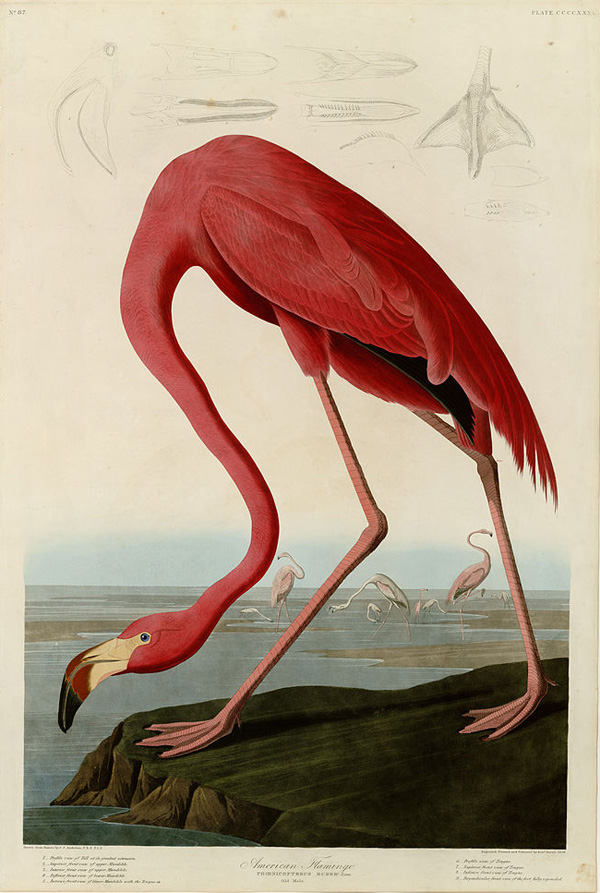 Birds of America (1827–38) by John James Audubon depicting American Flamingo. University of Pittsburgh/Wikimedia Commons” width=”290″ height=”432″>The mud flats were strewn with the shells of that small, exquisitely coloured mollusc, the rose tellin, looking like scattered petals of pink roses. There must have been a colony nearby, living buried just under the surface of the mud. At first the only creature visible was a small heron in grey and rusty plumage – a reddish egret that waded across the flat with the stealthy, hesitant movements of its kind. But other land creatures had been there, for a line of fresh tracks wound in and out among the mangrove roots, marking the path of a raccoon feeding on the oysters that gripped the supporting roots with projections from their shells. Soon I found the tracks of a shore bird, probably a sanderling, and followed them a little; then they turned toward the water and were lost, for the tide had erased them and made them as though they had never been.
Birds of America (1827–38) by John James Audubon depicting American Flamingo. University of Pittsburgh/Wikimedia Commons” width=”290″ height=”432″>The mud flats were strewn with the shells of that small, exquisitely coloured mollusc, the rose tellin, looking like scattered petals of pink roses. There must have been a colony nearby, living buried just under the surface of the mud. At first the only creature visible was a small heron in grey and rusty plumage – a reddish egret that waded across the flat with the stealthy, hesitant movements of its kind. But other land creatures had been there, for a line of fresh tracks wound in and out among the mangrove roots, marking the path of a raccoon feeding on the oysters that gripped the supporting roots with projections from their shells. Soon I found the tracks of a shore bird, probably a sanderling, and followed them a little; then they turned toward the water and were lost, for the tide had erased them and made them as though they had never been.
Looking out over the cove I felt a strong sense of the interchangeability of land and sea in this marginal world of the shore, and of the links between the life of the two. There was also an awareness of the past and of the continuing flow of time, obliterating much that had gone before, as the sea had that morning washed away the tracks of the bird.
The sequence and meaning of the drift of time were quietly summarised in the existence of hundreds of small snails – the mangrove periwinkles – browsing on the branches and roots of the trees. Once their ancestors had been sea dwellers, bound to the salt waters by every tie of their life processes. Little by little over the thousands and millions of years the ties had been broken, the snails had adjusted themselves to life out of water, and now today they were living many feet above the tide to which they only occasionally returned. And perhaps, who could say how many ages hence, there would be in their descendants not even this gesture of remembrance for the sea.
The spiral shells of other snails – these quite minute – left winding tracks on the mud as they moved about in search of food. They were horn shells, and when I saw them I had a nostalgic moment when I wished I might see what Audubon saw, a century and more ago. For such little horn shells were the food of the flamingo, once so numerous on this coast, and when I half closed my eyes I could almost imagine a flock of these magnificent flame birds feeding in that cove, filling it with their colour. It was a mere yesterday in the life of the earth that they were there; in nature, time and space are relative matters, perhaps most truly perceived subjectively in occasional flashes of insight, sparked by such a magical hour and place.
There is a common thread that links these scenes and memories – the spectacle of life in all its varied manifestations as it has appeared, evolved, and sometimes died out. Underlying the beauty of the spectacle there is meaning and significance. It is the elusiveness of that meaning that haunts us, that sends us again and again into the natural world where the key to the riddle is hidden. It sends us back to the edge of the sea, where the drama of life played its first scene on earth and perhaps even its prelude; where the forces of evolution are at work today, as they have been since the appearance of what we know as life; and where the spectacle of living creatures faced by the cosmic realities of their world is crystal clear.
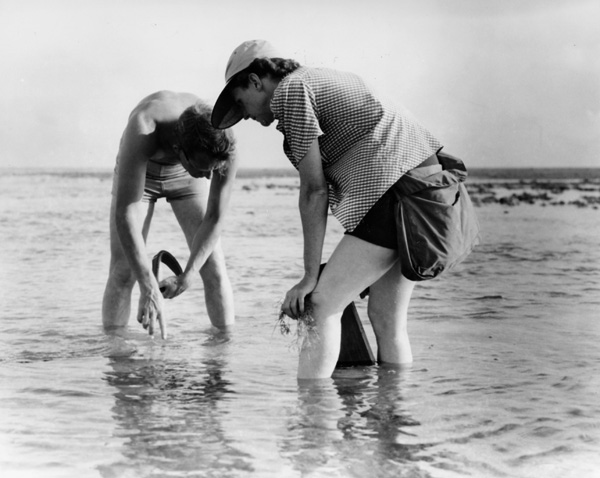 Rachel Carson (1907–1964) was an American marine biologist and conservationist whose book Silent Spring and other writings are credited with advancing the global environmental movement. She began her career as an aquatic biologist and became a full-time nature writer in the 1950s. She highlighted conservation, especially environmental problems that she believed were caused by synthetic pesticides, most notably DDT, and brought environmental concerns to a global audience through her writing, inspiring grassroots environmental movements across the planet. The Edge of the Sea, first published in 1955, is the third part of her Sea Trilogy to be reissued by Unicorn Press, along with The Sea Around Us (1951) and Under the Sea-Wind (1941). Read more.
Rachel Carson (1907–1964) was an American marine biologist and conservationist whose book Silent Spring and other writings are credited with advancing the global environmental movement. She began her career as an aquatic biologist and became a full-time nature writer in the 1950s. She highlighted conservation, especially environmental problems that she believed were caused by synthetic pesticides, most notably DDT, and brought environmental concerns to a global audience through her writing, inspiring grassroots environmental movements across the planet. The Edge of the Sea, first published in 1955, is the third part of her Sea Trilogy to be reissued by Unicorn Press, along with The Sea Around Us (1951) and Under the Sea-Wind (1941). Read more.
